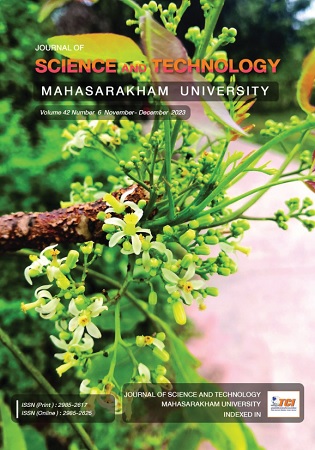The development of mixed reality for promoting community tourist routes, Bung Wai Sub-district, Warin Chamrap District, Ubon Ratchathani Province
Main Article Content
Abstract
การวิจัยครั้งนี้ มีวัตถุประสงค์เพื่อ 1) พัฒนาเทคโนโลยีโลกเสมือนผสานโลกแห่งความจริงสำาหรับส่งเสริมเส้นทางการท่องเที่ยว 2) ช่วยส่งเสริมการประชาสัมพันธ์และให้ความรู้เชิงวัฒนธรรมของวิถีชุมชน การดำาเนินการวิจัยแบ่งออกเป็น 4 ขั้น ได้แก่ การรวบรวมข้อมูลชุมชน การพัฒนาแอปพลิเคชัน การทดสอบประสิทธิภาพของเครื่องมือ และการถ่ายทอดองค์ความรู้สู่ชุมชน กลุ่มตัวอย่าง ได้แก่ ประชาชนในชุมชนและนักท่องเที่ยวในตำบลบุ่งหวาย จำนวน 120 คน ใช้วิธีการเลือกแบบเจาะจง (purposive sampling) เครื่องมือที่ใช้ในการวิจัยประกอบด้วย 1) แอปพลิเคชัน AR BungWaiTravel 2) แบบประเมินความเหมาะสมของแอปพลิเคชัน 3) แบบประเมินความพึงพอใจของผู้ใช้แอปพลิเคชัน สถิติที่ใช้ในการวิจัย ได้แก่ ค่าเฉลี่ยและส่วนเบี่ยงเบนมาตรฐาน
ผลการวิจัยพบว่า จากการพัฒนาแอปพลิเคชัน AR BungWaiTravel ได้ผลลัพธ์ 4 ส่วน ดังนี้ 1) แผ่นพับประชาสัมพันธ์แหล่งท่องเที่ยวบุ่งหวาย ประกอบไปด้วยแหล่งท่องเที่ยว 7 แห่ง และข้อมูลผลิตภัณฑ์ของตำบลบุ่งหวาย 2) สื่อมีเดียแหล่งท่องเที่ยวและโมเดล 3 มิติ ผลิตภัณฑ์เครื่องจักรสาน 3) คิวอาร์โค้ดตำแหน่งแหล่งท่องเที่ยวผ่านระบบนำาทาง Google Map 4) แอปพลิเคชันบนระบบปฏิบัติการแอนดรอยด์ชื่อ AR BungWaiTravel ผลการประเมินความเหมาะสมของแอปพลิเคชันจากผู้เชี่ยวชาญ พบว่า ผลการประเมินความเหมาะสมโดยรวมอยู่ในระดับดีมาก และ 2) ผลการประเมินความพึงพอใจของผู้ใช้แอปพลิเคชันสำหรับส่งเสริมเส้นทางการท่องเที่ยวชุมชนโดยภาพรวมอยู่ในระดับมาก
Article Details
References
Bogomolov, V. (2022) Top 5 ideas how to use AR in tourisms. https://www.hospitalitynet.org/opinion/4092421.html
Bungwai Subdistrict Administrative Organization. (2022). Data fundamental information of Bung Wai subdistrict administrative organization Warin Chamrap District, Ubon Ratchathani Province. https://www.bungwai.go.th
Chung, N., Han, H., & Joun, Y. (2015). Tourists’ intention to visit a destination: The role of augmented reality (AR) application for a heritage site. Computers in Human Behavior, 50, 588-599.
Dieck, M. & Jung, M. (2015). A theoretical model of mobile augmented reality acceptance in urban heritage tourism. Current Issues in Tourism. DOI:10.1080/13683500.2015.1070801
Jareonrup, N. (2017). The development of augmented reality technology: AR for tourist information of Wat Phrakaew in Chiangrai province. Journal of Modern Management Science, 10(1), 13-30.
Kaewsanga, K., Suteetorn, B., & Yoonaitharma, A. (2020). The public relations for creative tourism via social networking sites. Journal of Thai Hospitality and Tourism, 15(2), 14-28.
Nithiyuwith, T., & Kamtapol, Y. (2019). The tourism promotion application of 6 souvenirs that need to purchase in Phetchabun Province with the augmented reality Technology. Journal of Innovation Technology Management, 6(1), 179-189.
Park, S., & Stangl, B. (2020). Augmented reality experiences and sensation seeking. Tourism Management, 77, 104023.
Rattanawongsa, N., Phuttaoupatham, S., & Nusawat, P. (2019). AR HuaHin map guide. Sarakham Journal, 11(1), 33-44.
Revfne. (2022). How augmented reality is revolutionizing the travel industry. https://www.revfine.com/augmented-reality-travel-industry
Sarobol, S. (2003). Community based tourism concepts and experiences in the Northern area Chiang Mai community-based tourism network research and development project. The Thailand Research Fund (TRF).
The Ministry of Tourism and Sports Thailand. (2017). National tourism development plan no. 2 (2017-2021). The Ministry of Tourism and Sports Thailand.
Yonggulwanich, A. (2018). The development document for recommend cultural tourism in Plaklaow Village, Amnat Charoen Province. Journal of Srivanalai Vijai, 8(2), 15-26.


